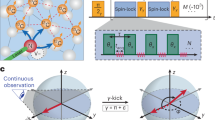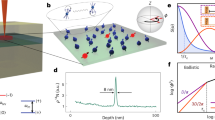Abstract
Understanding quantum dynamics away from equilibrium is an outstanding challenge in the modern physical sciences. Out-of-equilibrium systems can display a rich variety of phenomena, including self-organized synchronization and dynamical phase transitions1,2. More recently, advances in the controlled manipulation of isolated many-body systems have enabled detailed studies of non-equilibrium phases in strongly interacting quantum matter3,4,5,6; for example, the interplay between periodic driving, disorder and strong interactions has been predicted to result in exotic ‘time-crystalline’ phases7, in which a system exhibits temporal correlations at integer multiples of the fundamental driving period, breaking the discrete time-translational symmetry of the underlying drive8,9,10,11,12. Here we report the experimental observation of such discrete time-crystalline order in a driven, disordered ensemble of about one million dipolar spin impurities in diamond at room temperature13,14,15. We observe long-lived temporal correlations, experimentally identify the phase boundary and find that the temporal order is protected by strong interactions. This order is remarkably stable to perturbations, even in the presence of slow thermalization16,17. Our work opens the door to exploring dynamical phases of matter and controlling interacting, disordered many-body systems18,19,20.
This is a preview of subscription content, access via your institution
Access options
Access Nature and 54 other Nature Portfolio journals
Get Nature+, our best-value online-access subscription
$29.99 / 30 days
cancel any time
Subscribe to this journal
Receive 51 print issues and online access
$199.00 per year
only $3.90 per issue
Buy this article
- Purchase on Springer Link
- Instant access to full article PDF
Prices may be subject to local taxes which are calculated during checkout




Similar content being viewed by others
References
Adler, R. A study of locking phenomena in oscillators. Proc. IRE 34, 351–357 (1946)
Cross, M. C. & Hohenberg, P. C. Pattern formation outside of equilibrium. Rev. Mod. Phys. 65, 851–1112 (1993)
Schreiber, M. et al. Observation of many-body localization of interacting fermions in a quasirandom optical lattice. Science 349, 842–845 (2015)
Langen, T. et al. Experimental observation of a generalized Gibbs ensemble. Science 348, 207–211 (2015)
Smith, J. et al. Many-body localization in a quantum simulator with programmable random disorder. Nat. Phys. 12, 907–911 (2016)
Kaufman, A. M. et al. Quantum thermalization through entanglement in an isolated many-body system. Science 353, 794–800 (2016)
Wilczek, F. Quantum time crystals. Phys. Rev. Lett. 109, 160401 (2012)
Sacha, K. Modeling spontaneous breaking of time-translation symmetry. Phys. Rev. A 91, 033617 (2015)
Khemani, V., Lazarides, A., Moessner, R. & Sondhi, S. L. Phase structure of driven quantum systems. Phys. Rev. Lett. 116, 250401 (2016)
Else, D. V., Bauer, B. & Nayak, C. Floquet time crystals. Phys. Rev. Lett. 117, 090402 (2016)
von Keyserlingk, C., Khemani, V. & Sondhi, S. Absolute stability and spatiotemporal long-range order in Floquet systems. Phys. Rev. B 94, 085112 (2016)
Yao, N. Y., Potter, A. C., Potirniche, I.-D. & Vishwanath, A. Discrete time crystals: rigidity, criticality, and realizations. Phys. Rev. Lett. 118, 030401 (2017)
Childress, L. et al. Coherent dynamics of coupled electron and nuclear spin qubits in diamond. Science 314, 281–285 (2006)
de Lange, G., Wang, Z. H., Ristè, D., Dobrovitski, V. V. & Hanson, R. Universal dynamical decoupling of a single solid-state spin from a spin bath. Science 330, 60–63 (2010)
Doherty, M. W. et al. The nitrogen-vacancy colour centre in diamond. Phys. Rep. 528, 1–45 (2013)
Anderson, P. W. Absence of diffusion in certain random lattices. Phys. Rev. 109, 1492–1505 (1958)
Kucsko, G. et al. Critical thermalization of a disordered dipolar spin system in diamond. Preprint at https://arxiv.org/abs/1609.08216 (2016)
Deutsch, C. et al. Spin self-rephasing and very long coherence times in a trapped atomic ensemble. Phys. Rev. Lett. 105, 020401 (2010)
Rey, A. M., Jiang, L., Fleischhauer, M., Demler, E. & Lukin, M. D. Many-body protected entanglement generation in interacting spin systems. Phys. Rev. A 77, 052305 (2008)
Cappellaro, P. & Lukin, M. D. Quantum correlation in disordered spin systems: applications to magnetic sensing. Phys. Rev. A 80, 032311 (2009)
Waugh, J., Huber, L. & Haeberlen, U. Approach to high-resolution NMR in solids. Phys. Rev. Lett. 20, 180–182 (1968)
Basko, D., Aleiner, I. & Altshuler, B. Metal–insulator transition in a weakly interacting many-electron system with localized single-particle states. Ann. Phys. 321, 1126–1205 (2006)
Nandkishore, R. & Huse, D. A. Many-body localization and thermalization in quantum statistical mechanics. Annu. Rev. Condens. Matter Phys. 6, 15–38 (2015)
Abanin, D. A., De Roeck, W. & Huveneers, F. Exponentially slow heating in periodically driven many-body systems. Phys. Rev. Lett. 115, 256803 (2015)
Bruno, P. Impossibility of spontaneously rotating time crystals: a no-go theorem. Phys. Rev. Lett. 111, 070402 (2013)
Watanabe, H. & Oshikawa, M. Absence of quantum time crystals. Phys. Rev. Lett. 114, 251603 (2015)
Else, D. V., Bauer, B. & Nayak, C. Pre-thermal time crystals and Floquet topological phases without disorder. Preprint at https://arxiv.org/abs/1607.05277 (2016)
Choi, J. et al. Depolarization dynamics in a strongly interacting solid-state spin ensemble. Phys. Rev. Lett. (in the press)
von Keyserlingk, C. W. & Sondhi, S. L. Phase structure of one-dimensional interacting Floquet systems. II. Symmetry-broken phases. Phys. Rev. B 93, 245146 (2016)
Li, T.-Y. & Yorke, J. A. Period three implies chaos. Am. Math. Mon. 82, 985–992 (1975)
Yao, N. Y. et al. Many-body localization in dipolar systems. Phys. Rev. Lett. 113, 243002 (2014)
Acknowledgements
We thank D. A. Huse, S. L. Sondhi, A. Vishwanath and M. Zaletel for discussions, and N. P. De Leon and P. C. Maurer for fabricating the diamond nanobeam and experimental help. This work was supported in part by CUA, NSSEFF, ARO MURI, Moore Foundation, Harvard Society of Fellows, Princeton Center for Theoretical Science, Miller Institute for Basic Research in Science, Kwanjeong Educational Foundation, Samsung Fellowship, Purcell Fellowship, NSF PHY-1506284, NSF DMR-1308435, Japan Society for the Promotion of Science KAKENHI (No. 26246001), LDRD Program of LBNL under US DOE Contract No. DE-AC02-05CH11231, EU (FP7, Horizons 2020, ERC), DFG, SNF, Volkswagenstiftung and BMBF.
Author information
Authors and Affiliations
Contributions
S.C. and M.D.L. developed the idea for the study. J.C., R.L. and G.K. designed and conducted the experiment. H.S., S.O., J.I. and F.J. fabricated the sample. S.C., H.Z., V.K., C.v.K., N.Y.Y. and E.D. conducted the theoretical analysis. All authors discussed the results and contributed to the manuscript.
Corresponding author
Ethics declarations
Competing interests
The authors declare no competing financial interests.
Additional information
Reviewer Information Nature thanks D. A. Huse and the other anonymous reviewer(s) for their contribution to the peer review of this work.
Extended data figures and tables
Extended Data Figure 1 Effect of rotary echo sequence.
a, Experimental sequence: during the interaction interval τ1, the phase of the microwave driving along  is inverted after τ1/2. b, Comparison of time traces of P(nT), measured at even (green) and odd (blue) integer multiples of T, in the presence (left) and absence (right) of an
is inverted after τ1/2. b, Comparison of time traces of P(nT), measured at even (green) and odd (blue) integer multiples of T, in the presence (left) and absence (right) of an  rotary echo sequence at similar τ1 and θ (left, τ1 = 379 ns, θ = 0.979π; right, τ1 = 384 ns, θ = 0.974π). The rotary echo leads to more pronounced 2T-periodic oscillations at long time. The microwave frequencies used in the rotary echo sequence are Ωx = 2π × 52.9 MHz and Ωy = 2π × 42.3 MHz.
rotary echo sequence at similar τ1 and θ (left, τ1 = 379 ns, θ = 0.979π; right, τ1 = 384 ns, θ = 0.974π). The rotary echo leads to more pronounced 2T-periodic oscillations at long time. The microwave frequencies used in the rotary echo sequence are Ωx = 2π × 52.9 MHz and Ωy = 2π × 42.3 MHz.
Rights and permissions
About this article
Cite this article
Choi, S., Choi, J., Landig, R. et al. Observation of discrete time-crystalline order in a disordered dipolar many-body system. Nature 543, 221–225 (2017). https://doi.org/10.1038/nature21426
Received:
Accepted:
Published:
Issue Date:
DOI: https://doi.org/10.1038/nature21426
This article is cited by
-
Robust continuous time crystal in an electron–nuclear spin system
Nature Physics (2024)
-
Quantum many-body simulations on digital quantum computers: State-of-the-art and future challenges
Nature Communications (2024)
-
Eigenstate properties of the disordered Bose–Hubbard chain
Frontiers of Physics (2024)
-
A von-Neumann-like photonic processor and its application in studying quantum signature of chaos
Light: Science & Applications (2024)
-
Probing many-body dynamics in a two-dimensional dipolar spin ensemble
Nature Physics (2023)
Comments
By submitting a comment you agree to abide by our Terms and Community Guidelines. If you find something abusive or that does not comply with our terms or guidelines please flag it as inappropriate.



